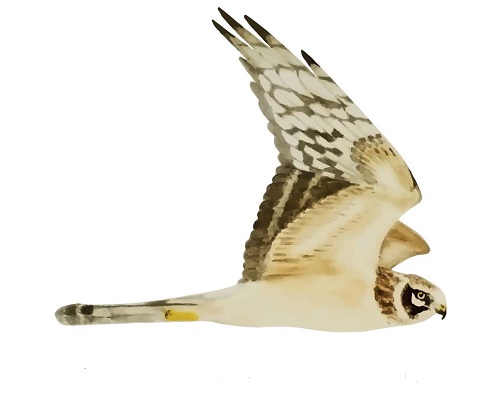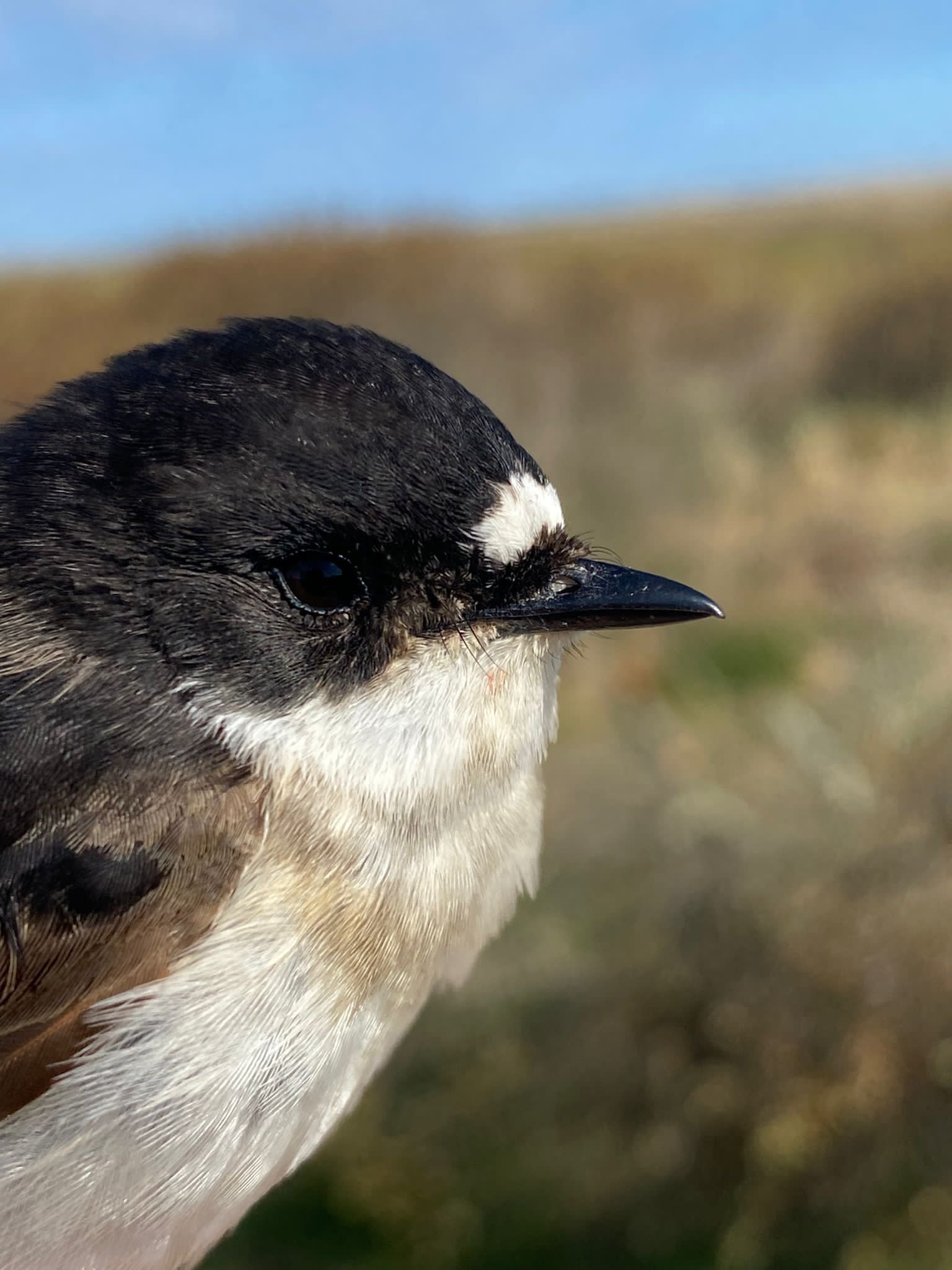Her på Skagen Fuglestations blog bringes korte nyheder i dagbogsformat om hændelser på fuglestationen.
Sooty Shearwater & Red-footed Falcon!
After a day off yesterday, Michael and Yehonatan had the nets at Kabeltromlen open at 4.30am. They had a quieter morning than expected but still managed to catch 26 birds including our fourth Skovsanger (Wood Warbler) of the spring.
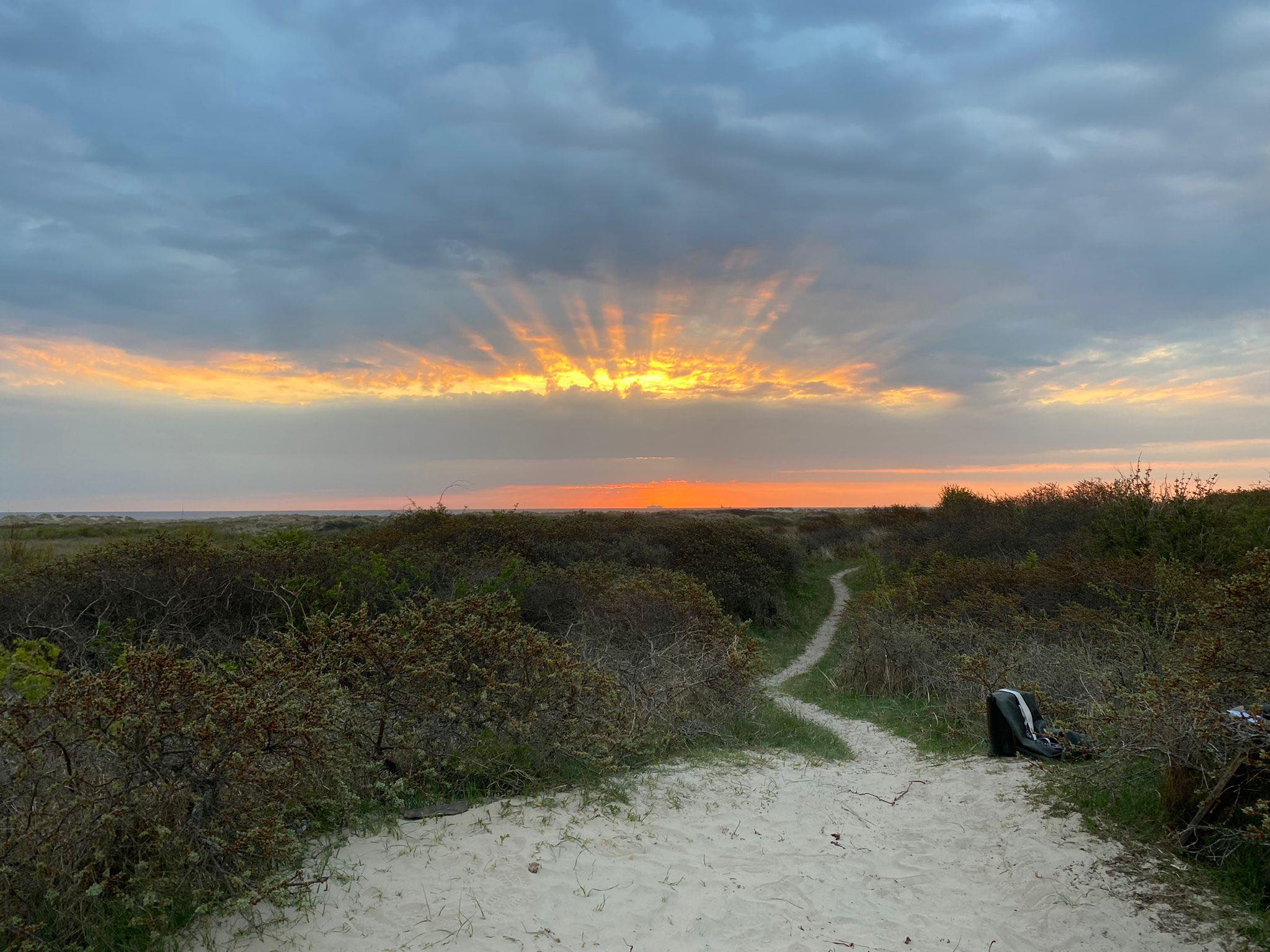
Sunrise at Kabeltromlen.
Dante again headed to the outer dunes whilst I joined Snäphor at the radar station for the day. We all had an excellent day observing including an adult, female Aftenfalk (Red-footed Falcon), 1 Topskarv (Shag), 1 Sodfarvet Skråpe (Sooty Shearwater) and 3 Dværgmåge (Little Gulls). Yet another adult, female Hedehøg (Montagu’s Harrier) was seen migrating and we even managed to observe it heading out to Sweden using the radar alongside numerous Hvepsevåge (Honey Buzzards), Rørhøg (Marsh Harriers) and Tårnfalk (Kestrels).
Yehonatan, Michael, Jesper, Mette and I spent the evening at Skarvsøen attempting to catch roosting Landsvale (Swallows) and Digesvale (Sand Martins) using playback. Unfortunately, we didn’t catch any this time, so we maybe need to rethink our technique before trying again.
A full list of today's observations can be found here.
Skagen Fuglestation: Yehonatan Ben Aroia, Michael Colley, Dante Shepherd, Lauren Evans, Jesper & Mette.
Kabeltromlen Ringing Totals:
Munk (Blackcap)- 6
Tornsanger (Common Whitethroat)- 5
Gærdesanger (Lesser Whitethroat)- 11
Løvsanger (Willow Warbler)- 2
Skovsanger (Wood Warbler)- 1
Bogfinke (Chaffinch)- 1
Total: 26
Skarvsøen Ringing Totals:
Løvsanger (Willow Warbler)- 1
Rørsanger (Reed Warbler)- 2
Rødstjert (Redstart)- 1
Total: 4
Skagen Hedehøg Record
Strong south-easterly winds meant it wasn’t possible to open the nets at Kabeltromlen in the morning but bought warm temperatures and a fantastic day for migration to make up for it. Lauren and I started the morning by leading a guided tour for a Birdlife Austria tour group, comprising of 20 visitors and our guests from the station apartment, Jesper and Mette. We head out through Grenen and along the tractor tracks to the beach and showed our group Gul Vipsjert (Yellow Wagtails), 2 Hedehøg (Montagu’s Harrier), 1 Steppehøg (Pallid Harrier), 2 Gøg (Cuckoos) and had amazing views of 4 Fjeldvåge (Rough-legged Buzzards) which were resting on the beach.
After our tour, Lauren and I headed back out to join Rolf, Alex and Henrik among the Grenen outer dunes. We had a fantastic few hours with 11 Biæder (European Bee-eaters), incredible views of an adult, male Aftenfalk (Red-footed Falcon) and another Hedehøg (Montagu’s Harrier). Throughout the day, a total of 11 different Hedehøg were seen in the area which represents a Skagen (and possibly a Danish?) record.
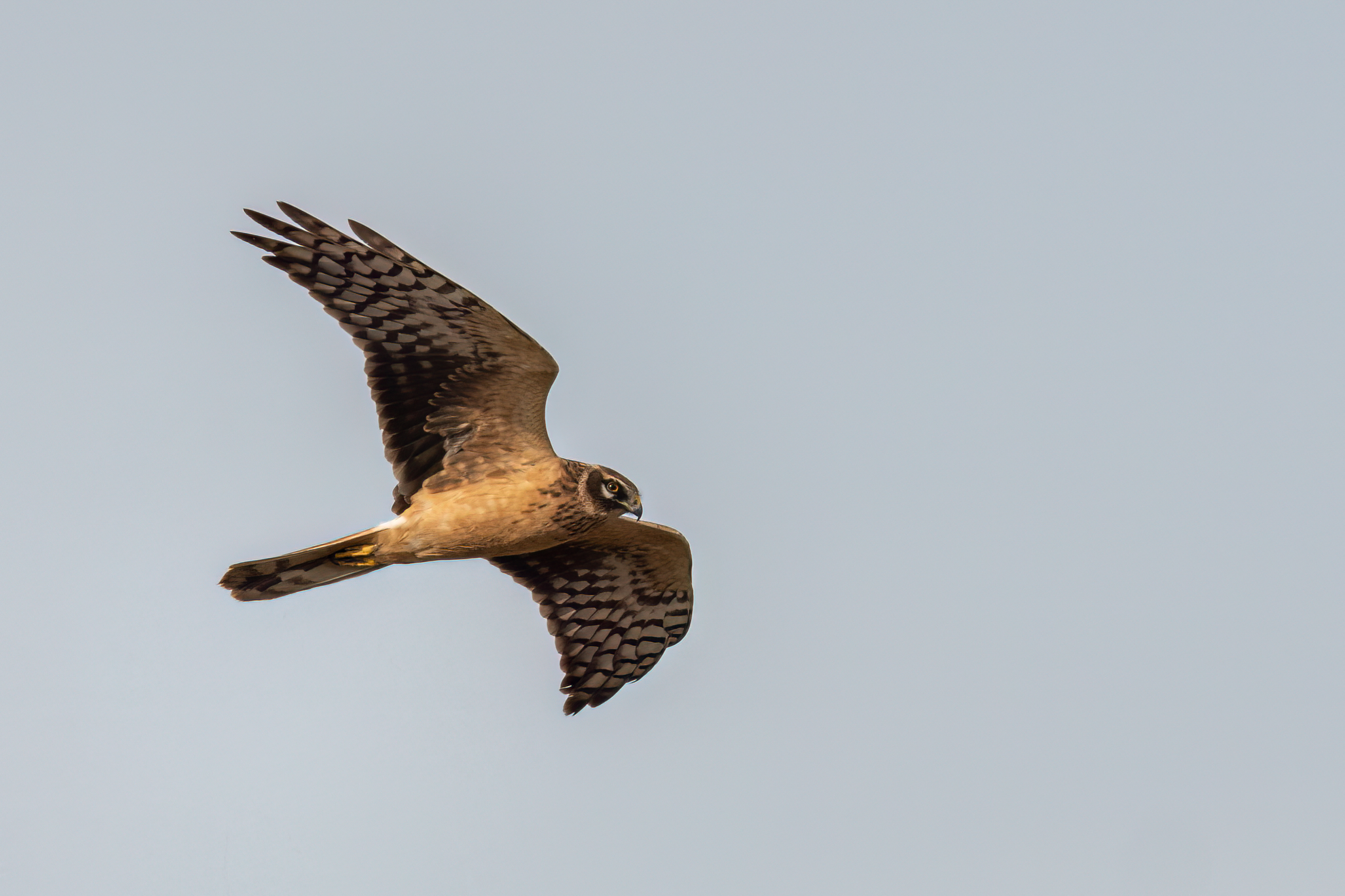
2k Steppehøg (Pallid Harrier). Photo: Erik Christophersen. https://ecskagen.blogspot.com/
Michael spent the afternoon out at the Aarhus University radar station with Snäphor using the laser binoculars and radar. They had a productive afternoon estimating the flight height and distance of migrating Rørhøg (Marsh Harriers), Hvepsevåge (Honey Buzzards) and Spurvehøg (Sparrowhawks).
A full list of today's observations can be found here.
Skagen Fuglestation: Yehonatan Ben Aroia, Michael Colley, Dante Shepherd, Lauren Evans, Jesper & Mette.
A special visitor in the ringing!
After alot of hesitation the night before if we should go ringing the next morning, or stay in due to the very strong winds, we (Yehonatan, Michael, Lauren and Ying) decided to give it go, and try to ring anyway. We woke up to very strong winds but decided to open some of the nets that are more pretected from the winds due to the high amounts of bird seen around the are in the last few days. We didn't catch too many birds, but we were lucky to catch a Sparrowhawk (Spurvhøg) that was ringed somewhere in the UK!. We sent an offical report to the ringing center and now waiting to get an awnser on when and where is was ringed.
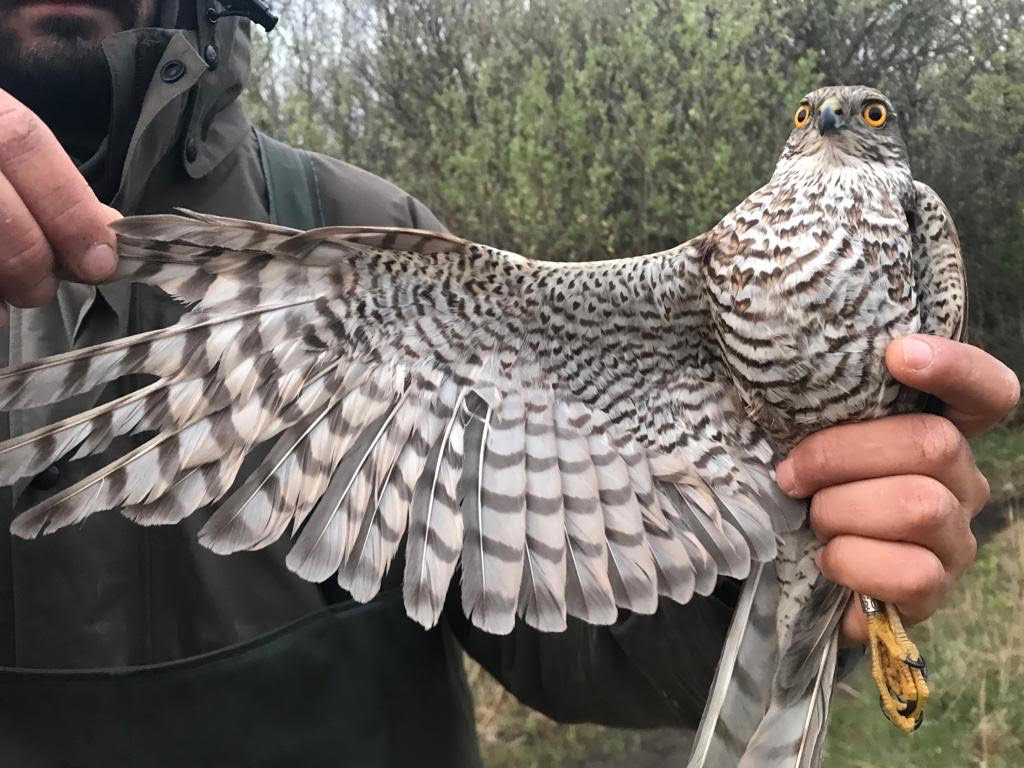
Between the few birds we caught, there was aslo the third Wood warbler (Skovsanger) for the season!
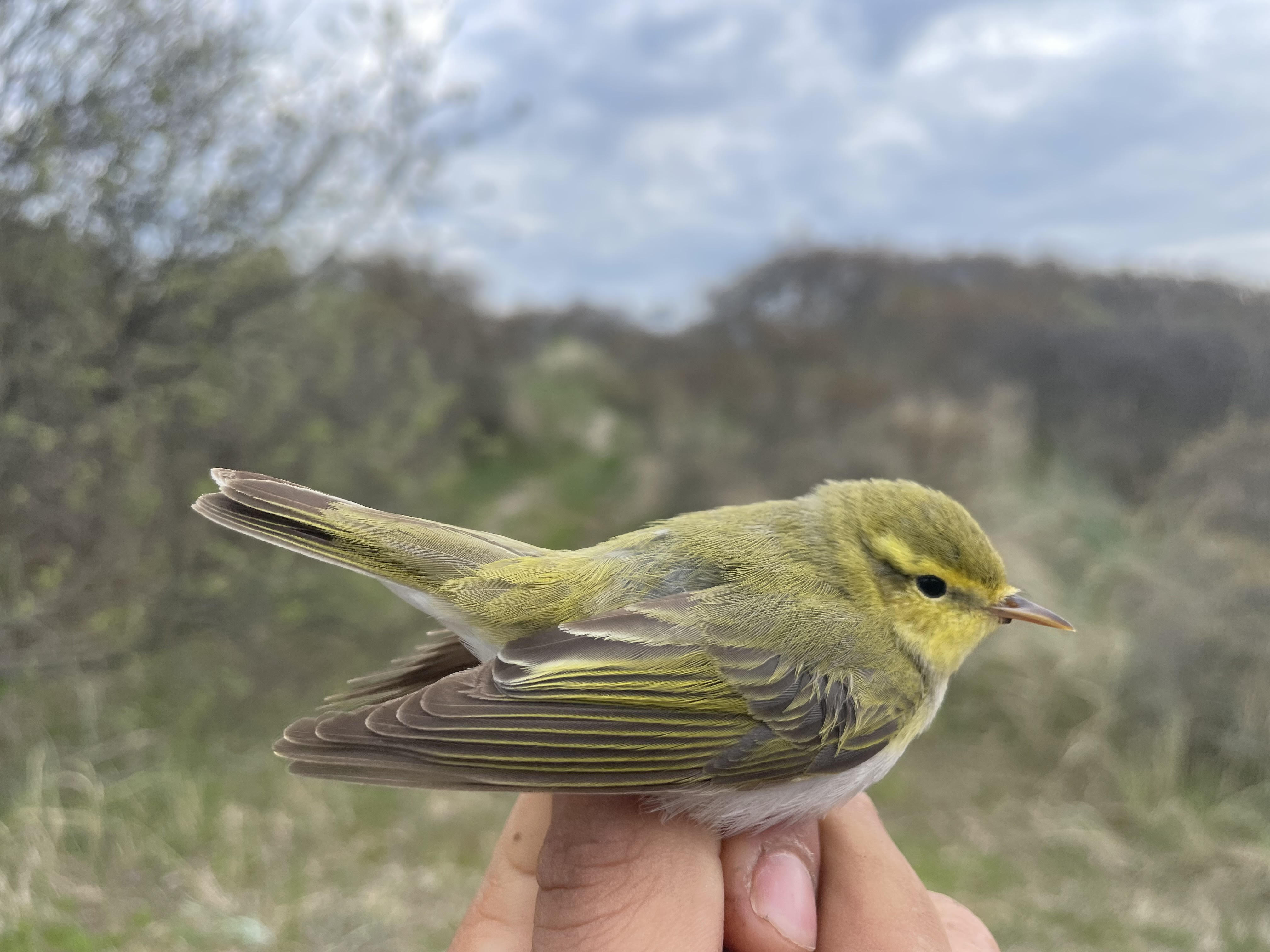
Meanwhile Dante had another chaotic day in World's end, with tons of birds moving around nonstop throughout the morning. Highlights were: more than 1000 Yellow Wagtails (Gul Vipstjert), Bee eater (Biædere), 63 Wood sandpipers (Tinksmed) Red-Footed Falcon (Aftenfalk), 3 Pallid Harriers (Steppehøg), Lesser-spotted eagle (Lille Skrigeørn), and many many more birds.
After a long day out, Michael made us all a very nice dinner, joined by Jesper & Mette, we all ended another day full of birds in the station, waiting to see what would show up tomorow.
A full list of today's observations can be found here.
Ringing Totals Kabletroumel:
Wood warbler (Skovsanger) - 1
Garen warbler (Havesanger) - 1
Tree pipit (Svovpiber) - 1
Lesser whitethroat (Gærdesanger) - 3
Willow warbler (Løvsanger) - 3
Sparrowhawk (Spurvhøg) - (1)
Total: 10
Raptors, Flycatchers, Vultures and many more
Waking up to dark and early morning and pleasant 9°C weather, Lauren, Yehonatan and I cycled out to the ringing site at 4am, greeted by a beautiful orange glow in the sky. It was again, a fantastically beautiful and peaceful environment to cycle in, listening to bird songs and watching them flitting through trees and shrubs. After setting up the nets, we walked back to the ringing station and were thrilled to find a few birds caught in the net, foreshadowing the busy birding activity to come.
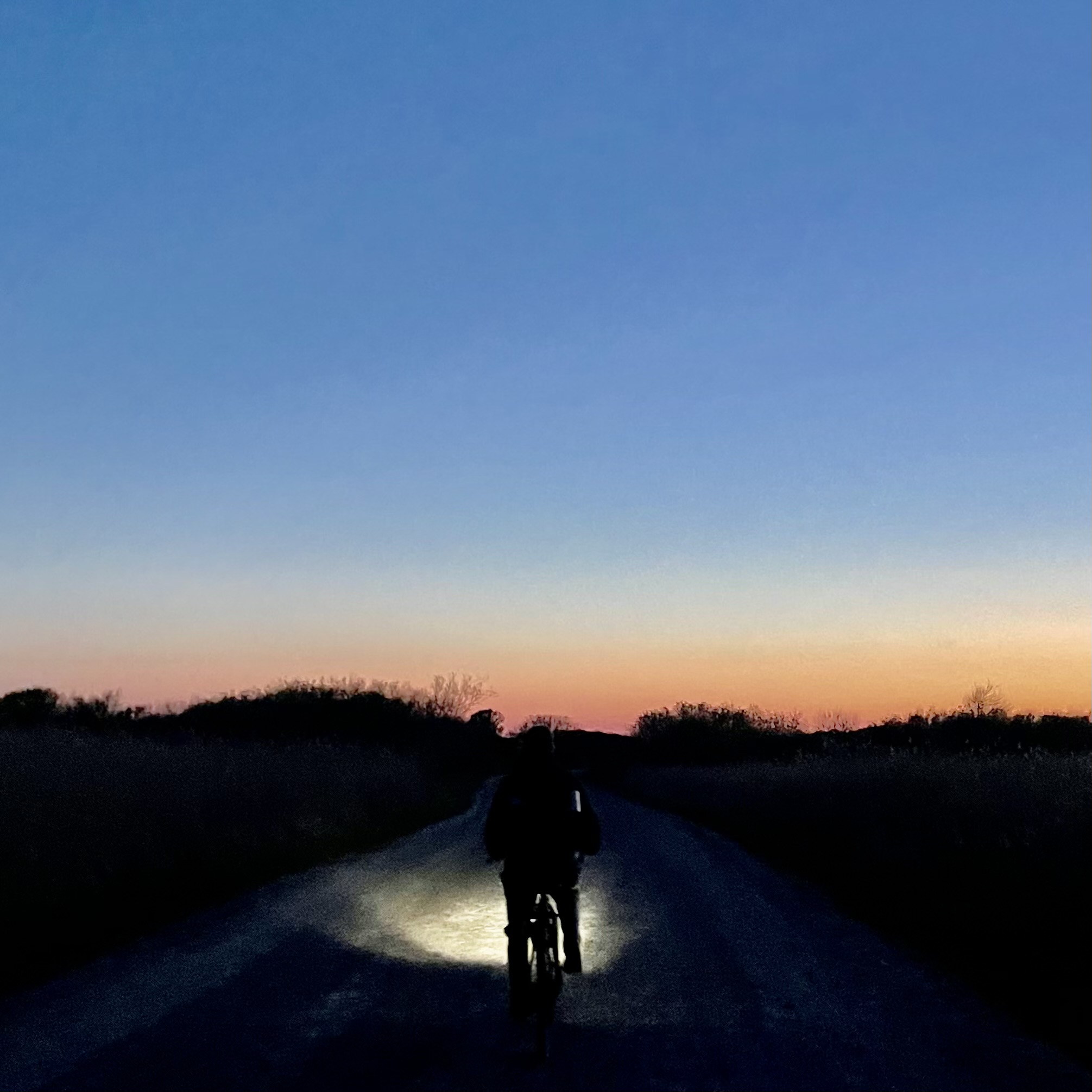
We were soon flooded with birds, both in the nets and up in the sky, and we needed two people to ring birds to catch the next round. I quickly scribed data, while Michael (who joined us later), helped to get more rings back at the Lighthouse. Despite the windy weather, there were unexpectedly many birds today, including firsts of the year for the station and firsts for us, such as the Tree Pipit (Anthus Trivialis), Wood Warbler (Phylloscopus Sibilatrix), Garden Warbler (Sylvia Borin), and even some surprises, like the Northern Willow Warbler (Phylloscopus Trochilus Acredula) subspecies, and a Spring visitor Redpoll (Carduelis Flammea) from Sweden!
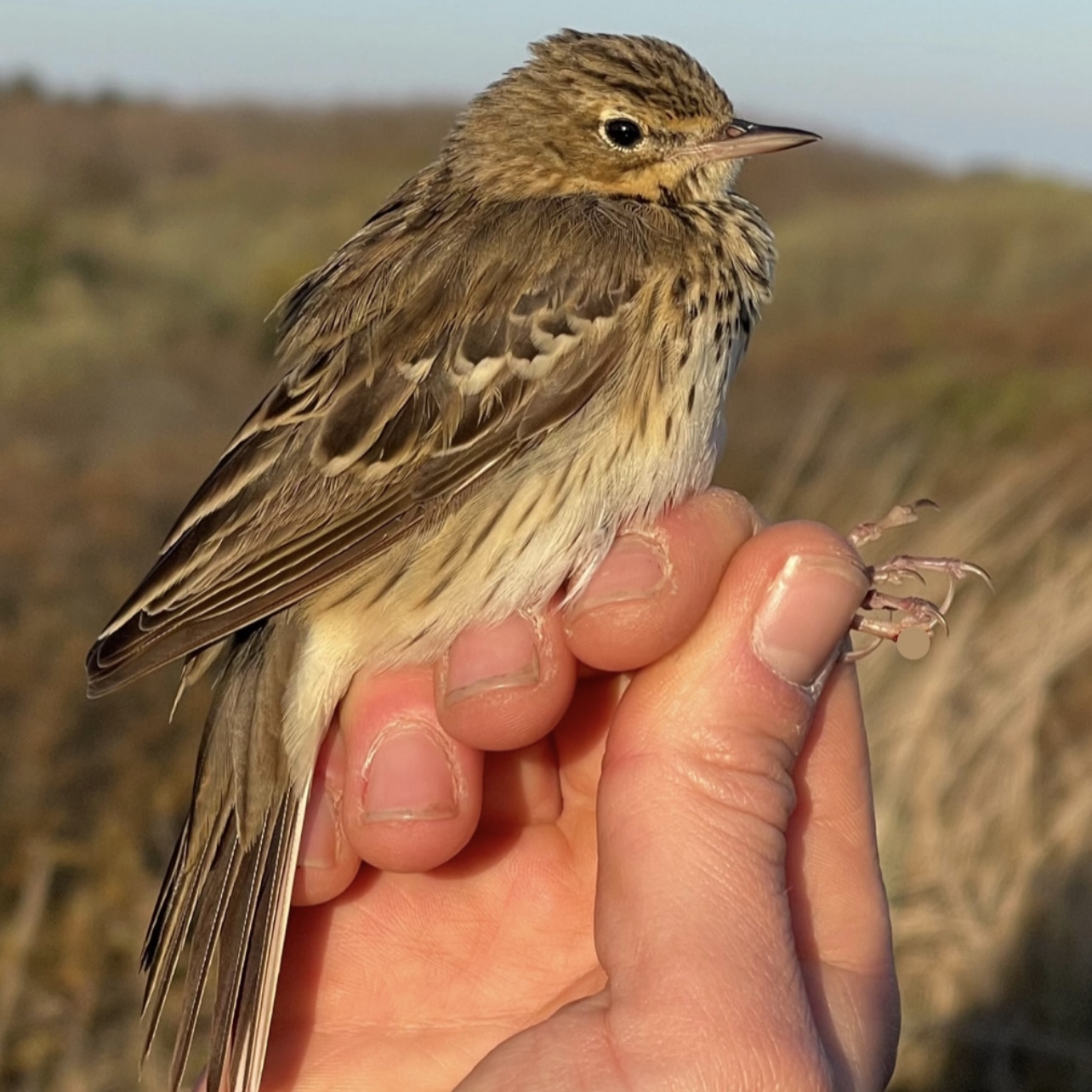
Tree Pipit
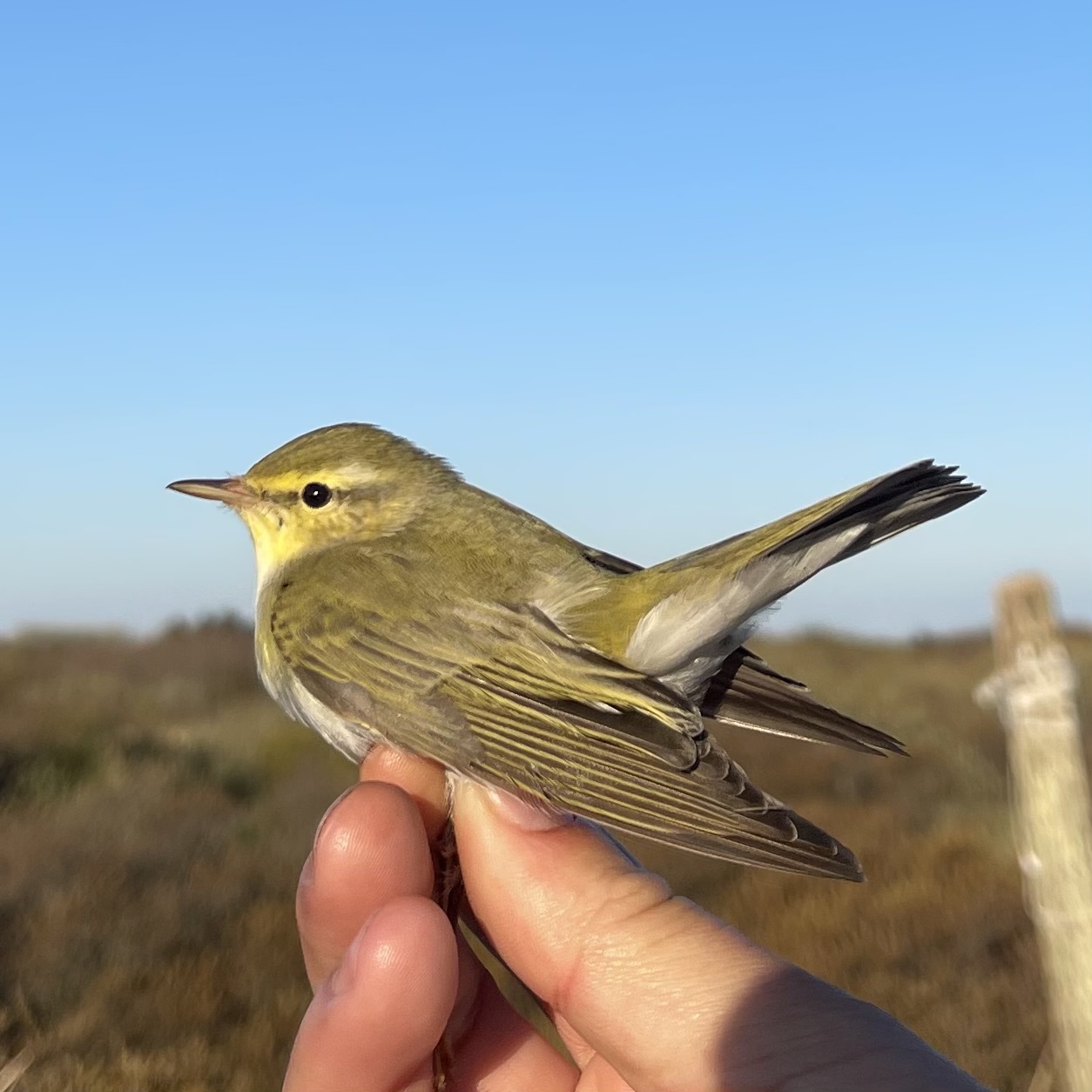
Wood Warbler
Looking up and out whenever we could, we saw flocks of Fieldfares (Turdus Pilaris) and over 200 Tree Pipits and voleries of over 150 Yellow Wagtails (Motacilla Flava) constantly flying past. Other birders who came to accompany us while we ringed pointed us to a Crossbill and Ring Ouzels perched on tree branches and helped us spot the bird of the day, the extraordinary Griffon Vulture (Gyps Fulvus) that made it onto Northern Jutlands news.
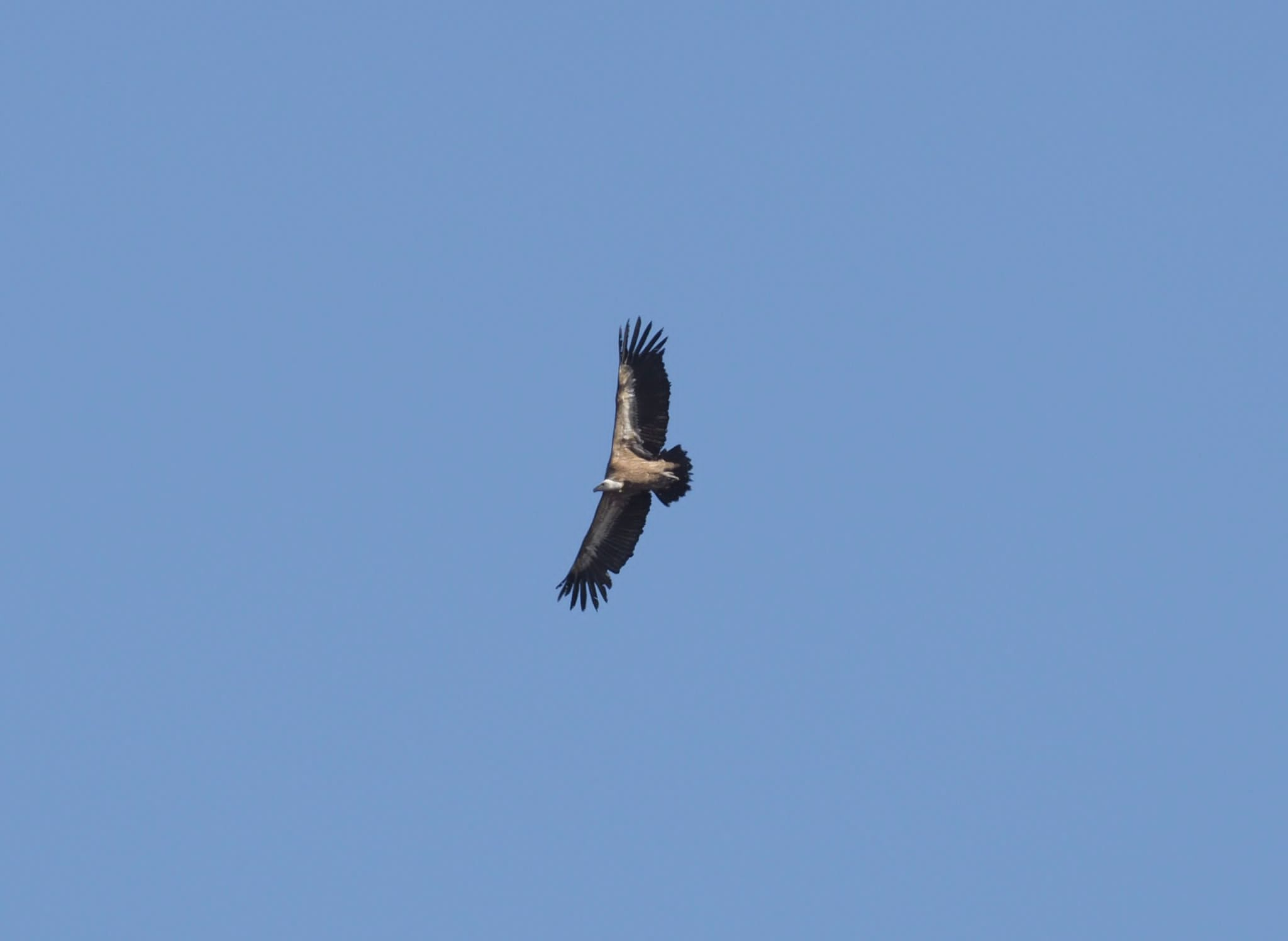
Griffon Vulture (Photo Credit: Lisa Vergin)
Raptor activity is in full bloom today. Besides the star of the day, there were also a Lesser Spotted eagle (Clanga Pomarina), 2 Red-footed Falcons (Falco Vespertinus), 20+ Honey Buzzards (Pernis Apivorus), 5 Black Kites (Milvus Migrans), 2 Pallid Harriers (Circus Macrourus) counted. Additionlly, there were also 3 White Storks, and Dante also saw Orioles and Bluethroats while observing and counting.
The bird migration season here is so different from Singapore’s but just as thrilling. Witnessing and experiencing it here while ringing and observing, I have seen, held and released many birds here, and am glad to contribute to the understanding of bird movements, population changes and its conservation efforts. I have also handling and extracted birds with the kind guidance and trust of Simon and the team. It is very interesting to see species that behave and look so familiar, and yet so foreign compared back home.
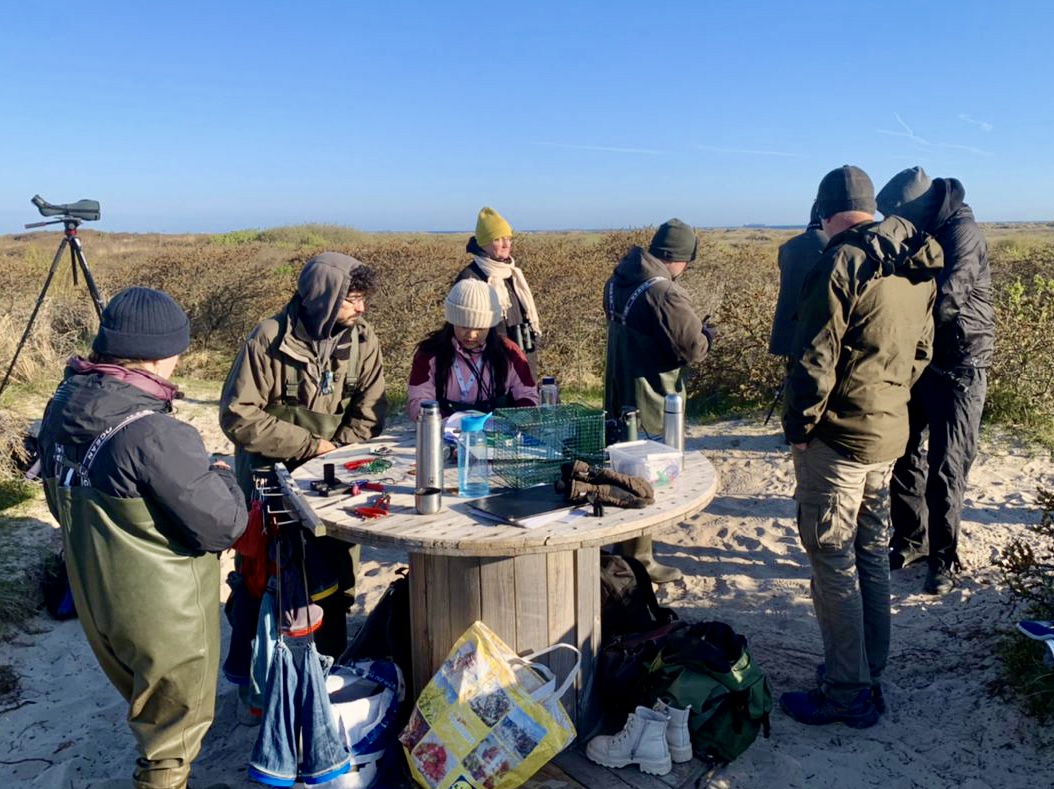
Learning bits and pieces of bird classification, identification, behavioral and ecological knowledge from everyone with the limited time I have here has been an immensely valuable experience. Also learning the names of many bird species in both Danish and English has been enjoyable, with locals demonstrating the pronunciations while I try my best to articulate them well. Eating cakes bought by lovely birders who accompanied us ringing and hearing the stories of birding ventures and the plans for the observatory, I am grateful for the opportunity to spend my time here at the Skagen Fuglestation and with the team and birders in Skagen.
Till next time!
Ying :-)

Skagen Fuglestation: Simon S. Christiansen Yehonatan Ben Aroia, Michael Colley, Toh Ying Ying, Dante Shepherd, Lauren Evans.
Battle of the Towers
Yehonatan, Michael and Ying had the nets open at surnise at Kabeltromlen and were joined by our guests, Martin and Kristine. After an initial slow start, they managed to ring 15 birds including a young, male Spurvehøg (Sparrowhawk), 3 Lille Gråsisken (Lesser Redpoll) and 2 Brøget Fluesnapper (Pied Flycatchers) which were definitely worth getting up early for.
Dante and I headed to World's End, alongside Simon and Lisa, and met the 25 or so other birders gathered for the 'Battle of the Towers'. This is a friendly competition held across Scandanavia where the aim is to see the highest number of species between 5am and 1pm. Despite migration feeling rather slow, we altogether managed a highly respectable 98 species including highlights of Gulirisk (Serin), Lærkefalk (Hobby), Islom (Great Northern Diver) and Mallemuk (Northern Fulmar).
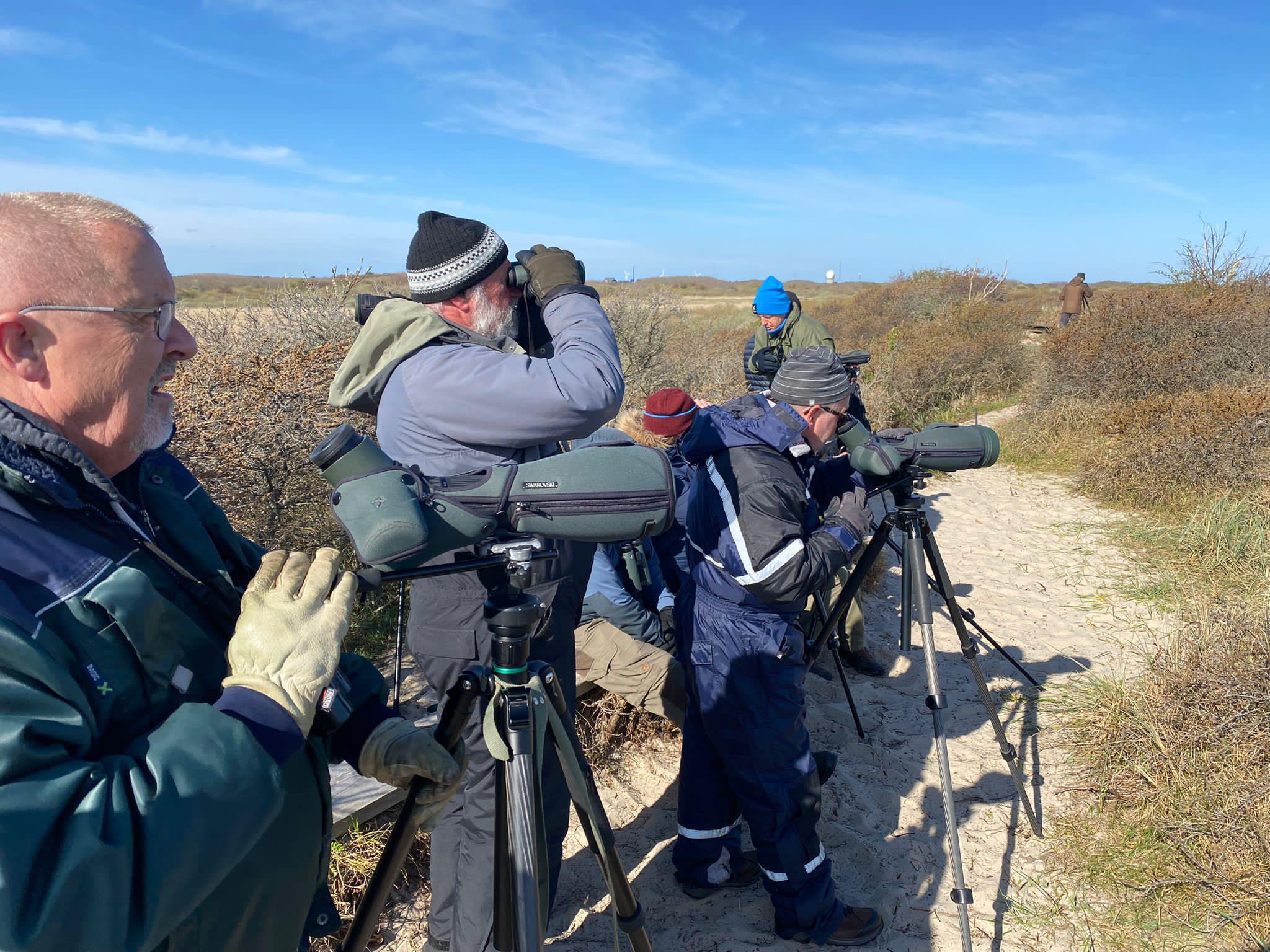
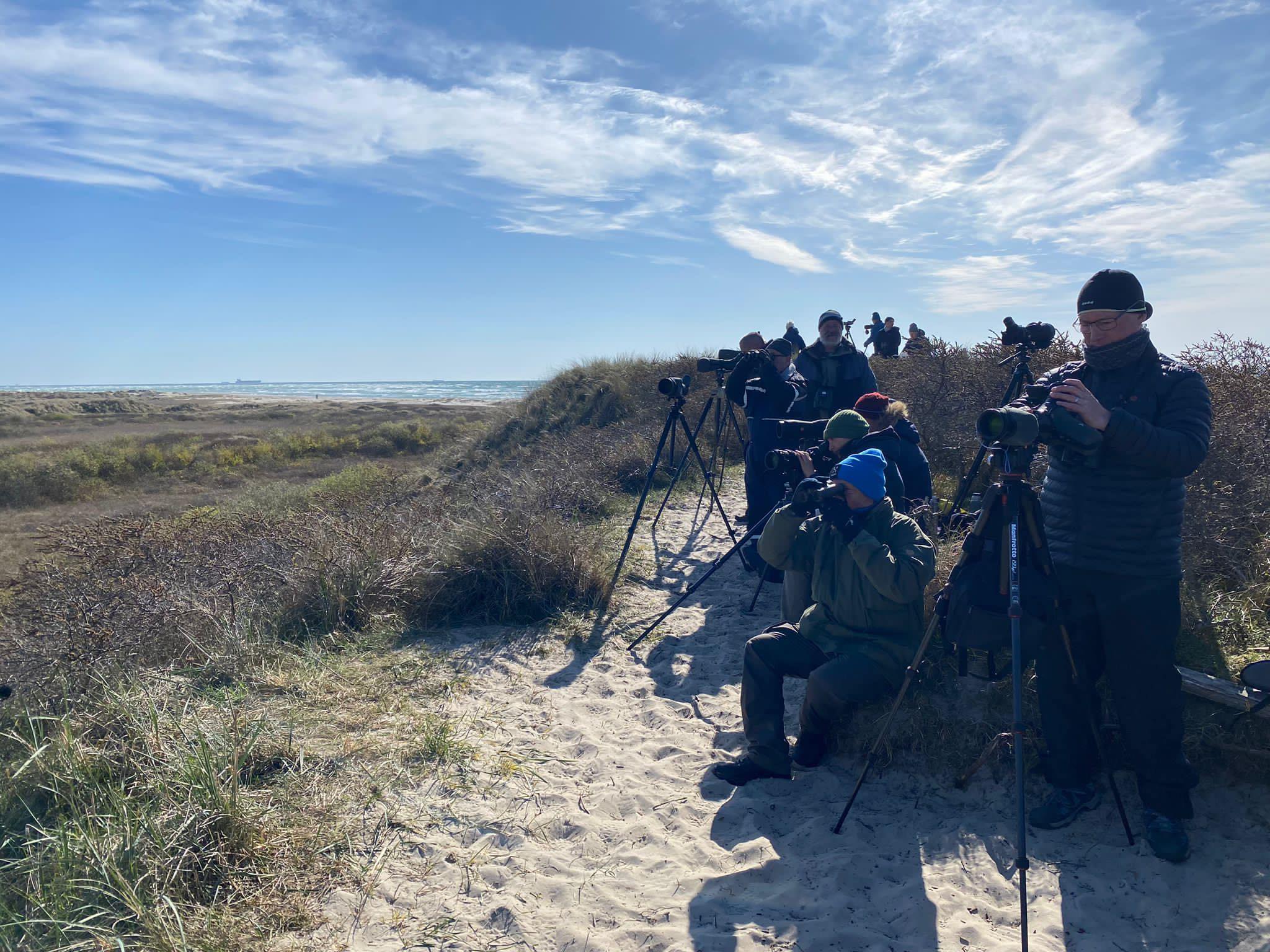
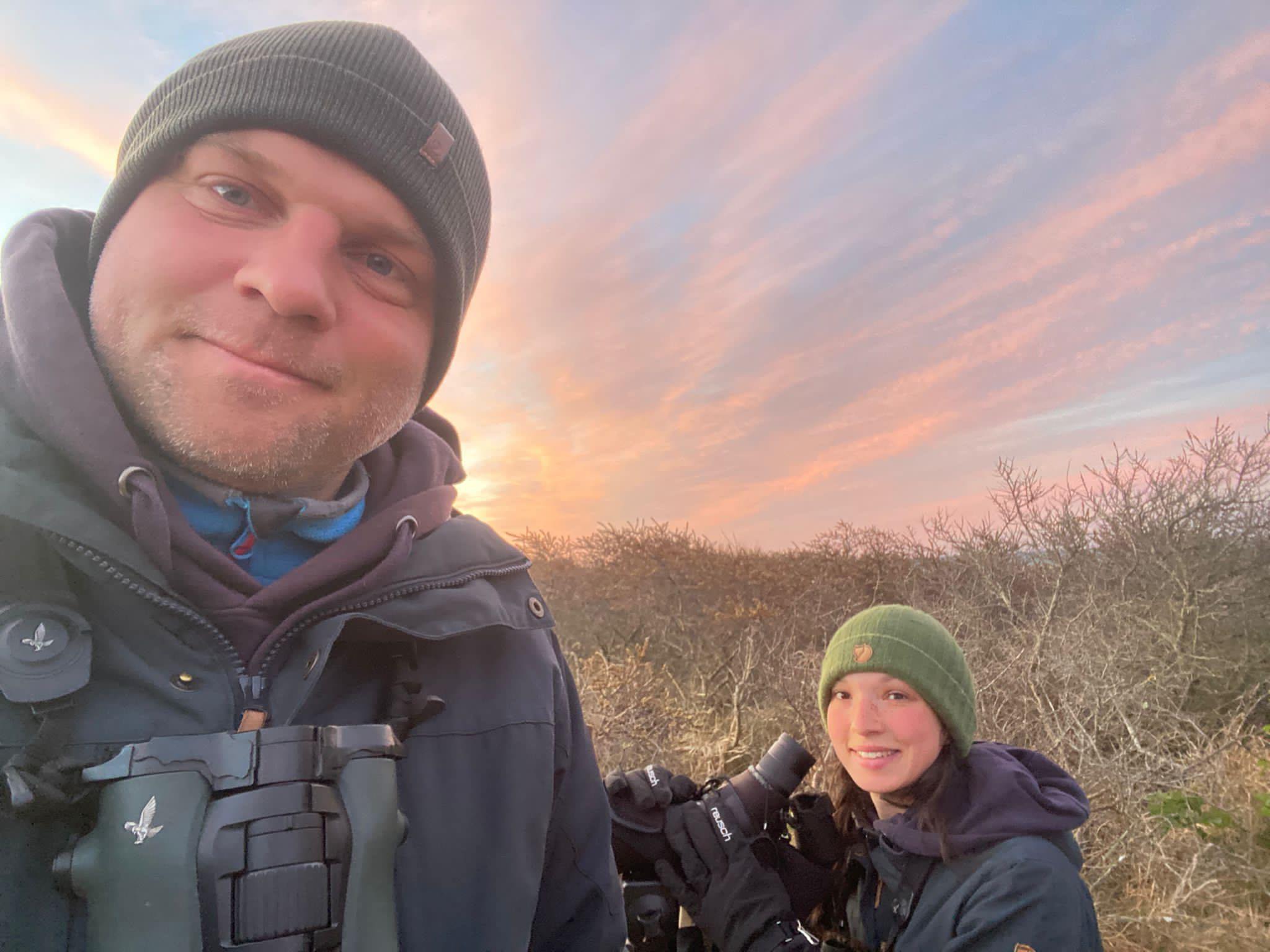
Birders gathered at World's End for the 'Battle of the Towers'.
After a rather slow morning, raptor migration really picked up in the afternoon with an adult, female Aftenfalk (Red-footed Falcon), a 2k Steppehøg (Pallid Harrier) and Hedehøg (Montagu's Harrier) all seen across Skagen. The undoubted highlight of the day was a 2k Høgeørn (Bonelli's Eagle), found south of the station near Skagen Camping. Dante, Ying and I all jumped into the car with Martin and raced to Hulsig but unfortunately it had disappeared by the time we arrived- fingers crossed it heads our way tomorrow!
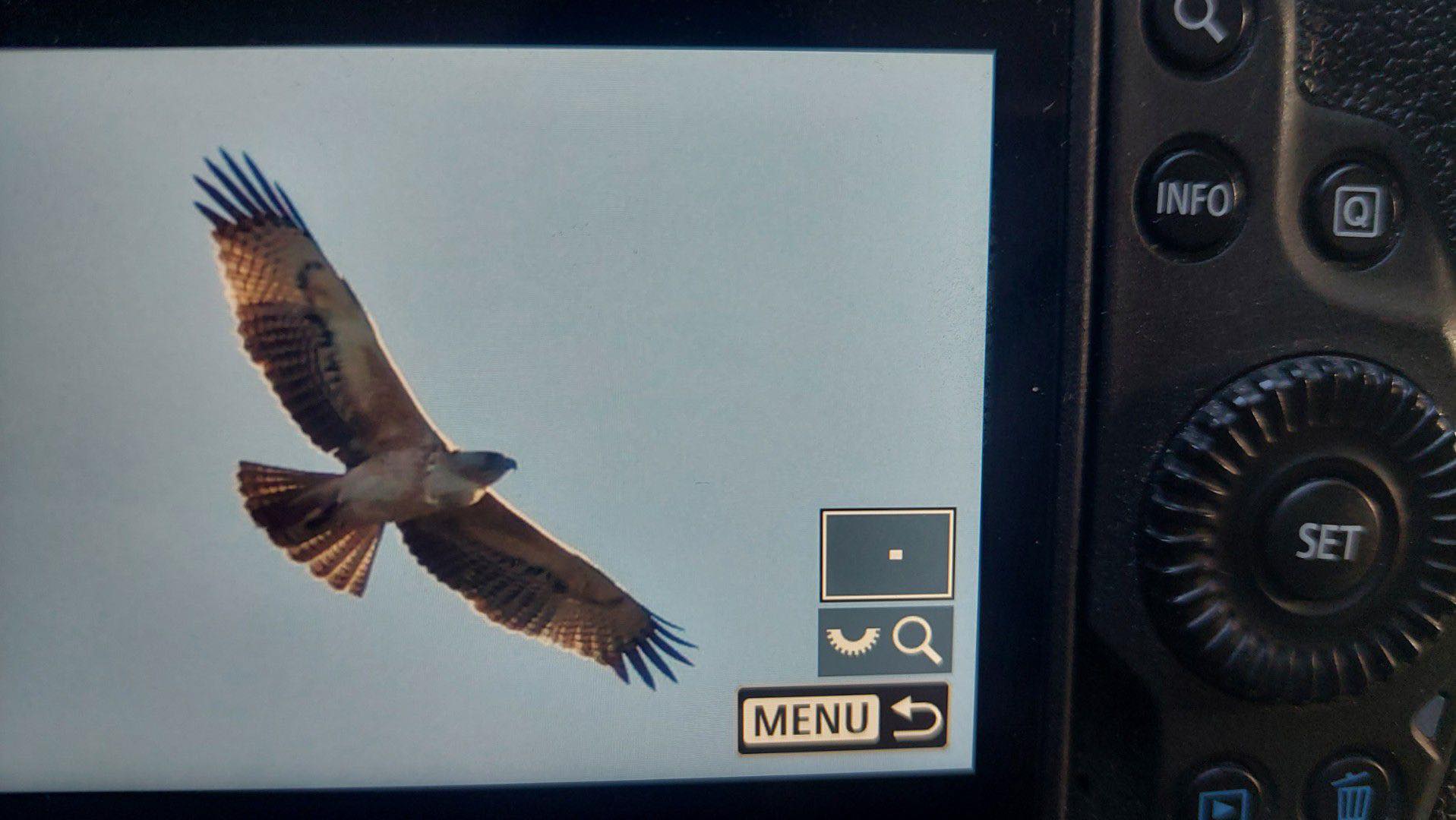
Back-of-camera shot of the 2k Høgeørn (Bonelli's Eagle). Photo: Jan Eske Schmidt.
A full list of today's observations can be found here.
Skagen Fuglestation: Yehonatan Ben Aroia, Michael Colley, Toh Ying Ying, Dante Shepherd, Lauren Evans, Martin & Kristine.
Kabeltromlen Ringing Totals:
Løvsanger (Willow Warbler)- 2
Lille Gråsisken (Lesser Redpoll)- 3
Gærdesanger (Lesser Whitethroat)- 6
Sivsanger (Sedge Warbler)- 1
Brøget Fluesnapper (Pied Flycatcher)- 2
Spurvehøg (Sparrowhawk)- 1
Total: 15
The big prayer day!
Another windy and sunny morning, I (Yehonatan) was able to join the ringing after a couple of sick days in bed, and it's good really good to be able to go out and participate in the outdoor activities again. I joined Lauren, Ying, Michael, and Simon in the ringing, while Dante went to wrolds end 1 as usual, i wonder if he'll join us one time in the ringing before i leave (The chances aren't good) but anyways we had a nice morning with some cool variety.
Male Pied flycatcher (Brogget fluesnnaper) from the ringing today.
Highlight from the field, are a While-billed diver (Hvidnæbbet lom), Great- Northen diver (Islom) that flew right overhead, and gave all of us an amazing view, and many more wonderful birds.
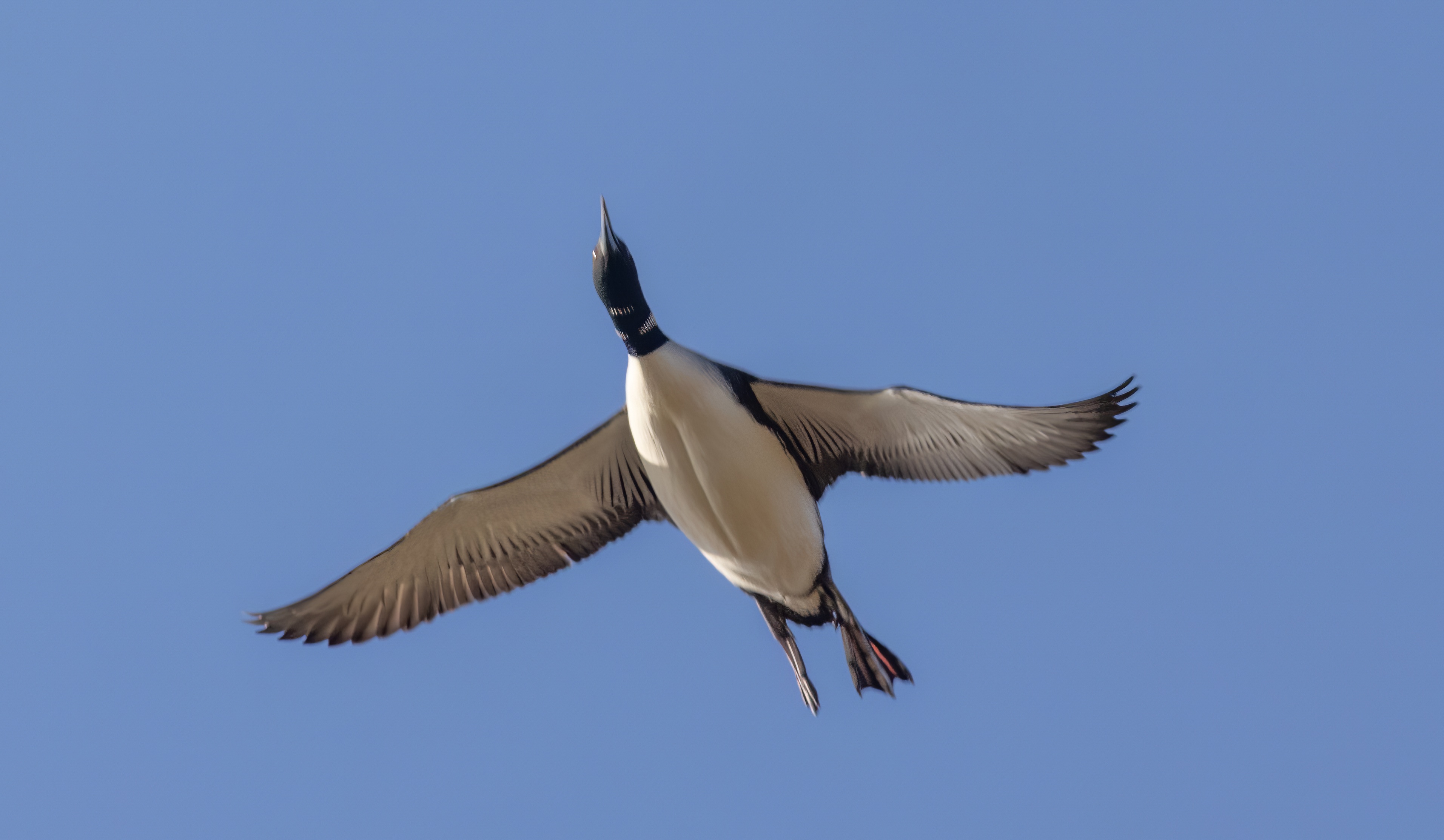
Photo: Christian Andersen Jensen
Many people joined us in the ringing this morning, a nice use of the Big prayer holiday, and it was quite full around the ringing table, we are always welcoming anyone to come and watch the ringing! One special guest we had the chance to meet today, was Ib Albin Olsen, which used to ring birds in Skagen back in the 60's-70's! How amazing it is that it is still done today, and how lucky we all were to learn from such an expirienced person, and he also had the chance to bring up some memories and see some nice birds today!
Its busy around the rining table!
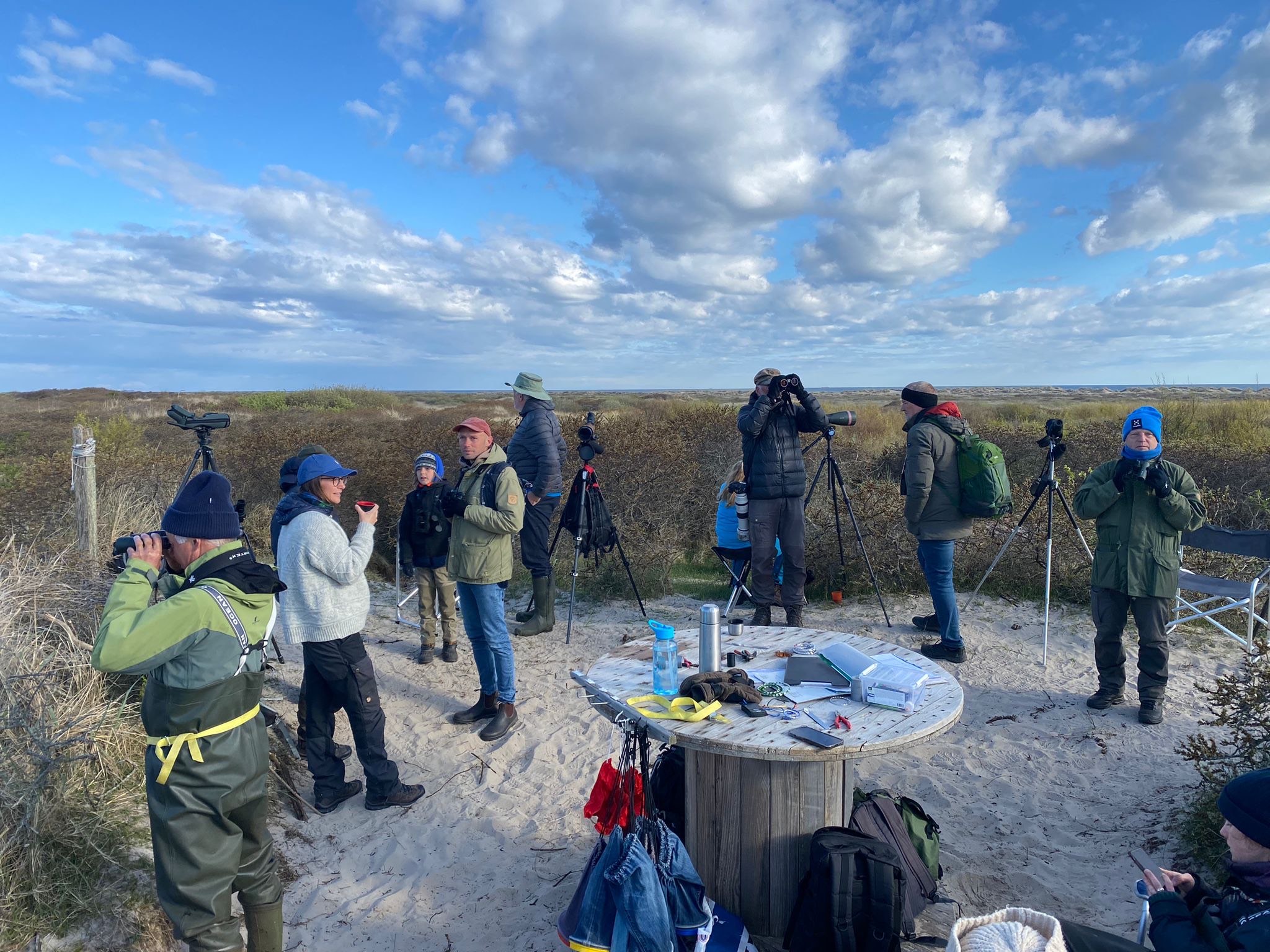
A full list of today's observations can be found here.
Ringing Totals Kabletroumel:
Chiffchaf (Gransanger) - 11
Willow Warbler (Løvsnager) - 8
Blackcap (Munk) - 4
Reed Bunting (Rørspurv) - 3
Chaffinch (Bogfinke) - 1
Reed Warbler (Rørsanger) - 1
Pied Flycatcher (Brogget fluesnnaper) - 1
Redstart (Rødstjert) - 2
Robin (Rødhals) - 2
Goldcrest (Fuglekonge) - 2
Wren (Gærdesmutte) - 3
Wood Warbler (Skovsanger) - 1
Total - 39
Busy day
Dear blog Readers
The ringing this morning was so nice because there were many birds which keeps the ringing busy. The weather was nice for birds because it was cloudy the hole morning and when that happen, there is always hope that is going to be good for ringing and birding .
The ringing this morning, we caught 82 birds of 10 species that include Redstart that was the first Redstart to be caught during this years spring 2023. Those that were at the ringing site as volunteers are Lauren and Yin, with Simon who was there to oversee the ringing.
Yehonatan could not attend the ringing because he has not been feeling well since yesterday and today, but hoping that he will join us tomorrow or next because he is getting better now, the guest in the apartment were also at the ringing site. They were students with special education needs came to for a visit at the ring site too.

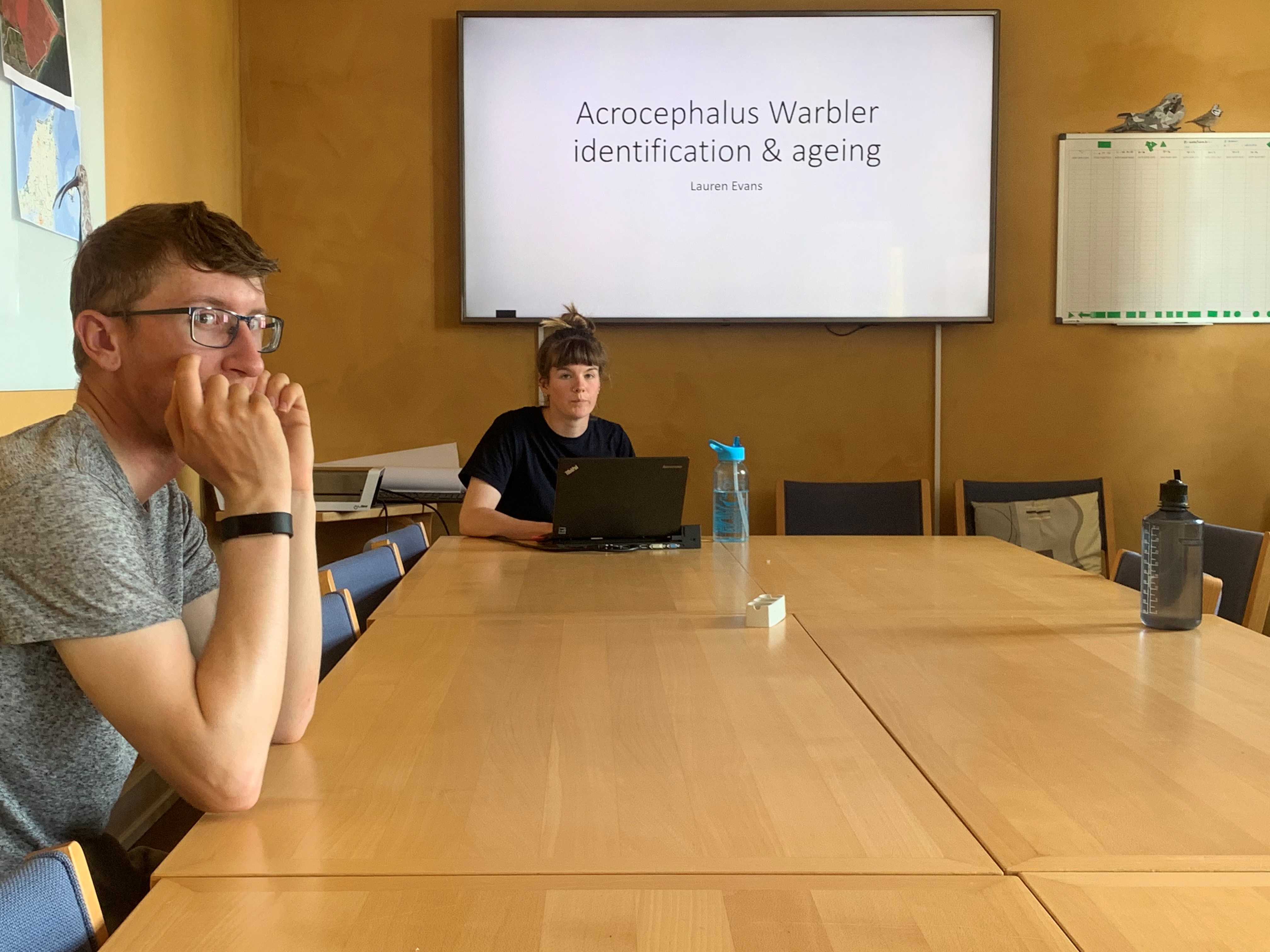
The ringing total = 82
common Redstart / Rødstjert 2
Reed bunting / Rørspure 4
Lesser Whitethroat / Gærdesabger 8
Song Thrush / Sandrossel 3
Wren / Gærdesmutte 3
Sedge Warbler / Sivsanger 1
Robin / Rødhals 5
Chiffchaff / Gransanger 17
Willow Warbler / Løvsanger 29
Blackcap / Munk 10
This morning I went out to help Snåphor from Aarhus University on the radar survey , which was a good experience for me , he tech me many things about the radar, but it was not good as expected because it was a bit windy out at the beach. But we were able to taget up three species they are, Barnacle Goose, Red-throated Diver and Sparrow hakes .He has special Barnacles that can help you know the distance the bird is flying from were you are and the high from the grown, it was a good experience for me to lean.
The observation this morning was not as expected because it was cloudy with a lot of expectation is going to be good as to the ringing but it different, it was later windy and they were less birds migrating , and Dante was on the observation side and this is the list of birds he has seen on the observation side.
Great Northern Diver / Islom 3
Whinchat / Bynketugl 15
Black-threated Diver / Sortstrubet lom 7
Redstart / Rødstiert 5
Ringing & Radar
Another early start for the whole team as Michael, Ying and I headed to Kabeltromlen to open the nets. This was my first time leading a ringing session here now I’ve progressed to a C permit and overall, I think it went well. We had a good catch of 40 birds including plenty of spring migrants as well as 2 Lille Gråsisken (Lesser Redpoll).
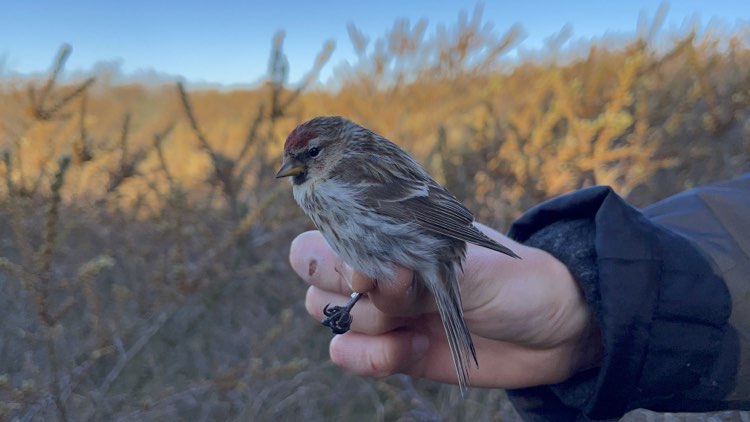
Lille Gråsisken (Lesser Redpoll).
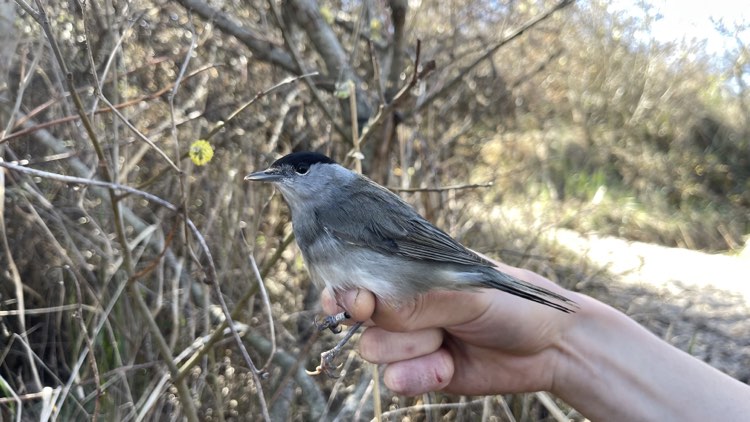
Munk (Blackcap).
Meanwhile, Dante headed out to World’s End 3 to join Snäphor from Aarhus University, at the radar station. They had a long, yet productive, day measuring the flight height and distance of migrating Musvåge (Buzzards), Blå Kærhøg (Hen Harriers), Rørhøg (Marsh Harriers) and Islom (Great Northern Divers). Throughout the day, 1 Skestork (Spoonbill), 1 Biæder (Bee-eater), 1 Gulirisk (Serin), 4 Islom (Great Northern Diver), 1 Kongeørn (Golden Eagle) and 1 Hvidvinget Måge (Iceland Gull) were also seen.
A full list of today's observations can be found here.
Skagen Fuglestation: Yehonatan Ben Aroia, Michael Colley, Dante Shepherd, Lauren Evans, Toh Ying Ying, Martin & Kristine.
Kabeltromlen Ringing Totals:
Rødhals (Robin)- 7
Munk (Blackcap)- 9
Gransanger (Chiffchaff)- 7
Gærdesanger (Lesser Whitethroat)- 2
Fuglekonge (Goldcrest)- 1
Gærdesmutte (Wren)- 3
Lille Gråsisken (Lesser Redpoll)- 2
Løvsanger (Willow Warbler)- 1
Rørspurv (Reed Bunting)- 8
Total: 40
Warbler Wonderland
First day here in the Skagen Bird Observatory to participate in the first Constant Effort Site (CES) session of the year. The aim of the CES is to better understand and investigate changes in breeding bird populations through standardised procedures! Yonathan, Lauren, Michael, and I cycled to the site, with faint lights starting to paint the morning sky orange at 4 am. The atmosphere while we were cycling was peaceful, and we reached the site and began opening nets around the area. Simon brought a table to set up the ringing station, and we soon began our rounds around the site.
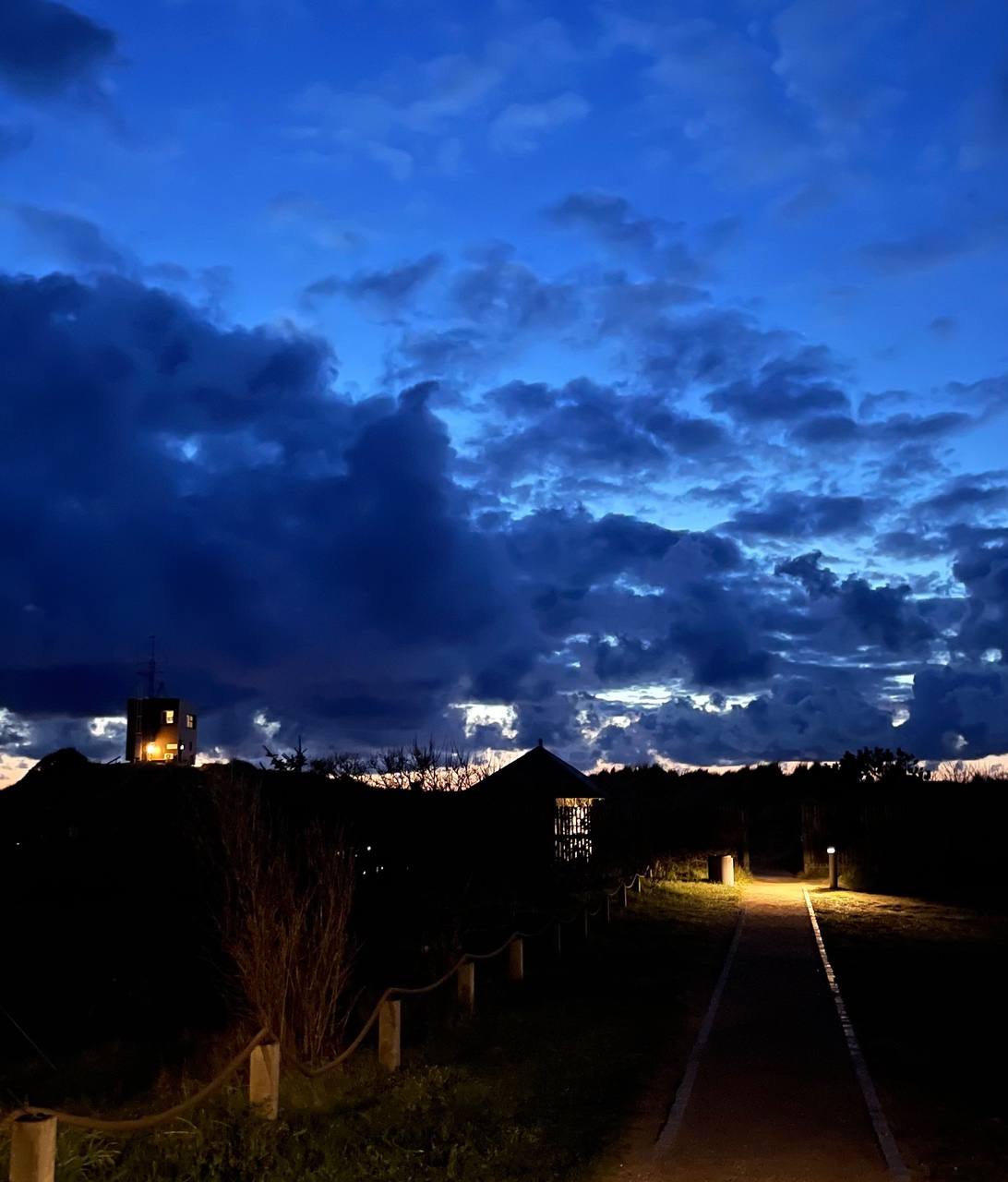
The ringing session was very fruitful, and I saw all the birds in person for the first time in my life, which was very exciting after being able to see them online. The birds were less colourful than the ones in Singapore, but they had a lot of personality, and some were quite feisty despite their duller appearances. We caught 44 birds, including several willows and chiffchafs and a recaptured Lesser Whitethroat (Sylvia Curruca) caught back from 2019 at the same location.
The highlight of the day was definitely the male Bearded Reedling (Panurus biarmicus), the first of the year in the station, making the extra early wake-up call for everybody worth it.
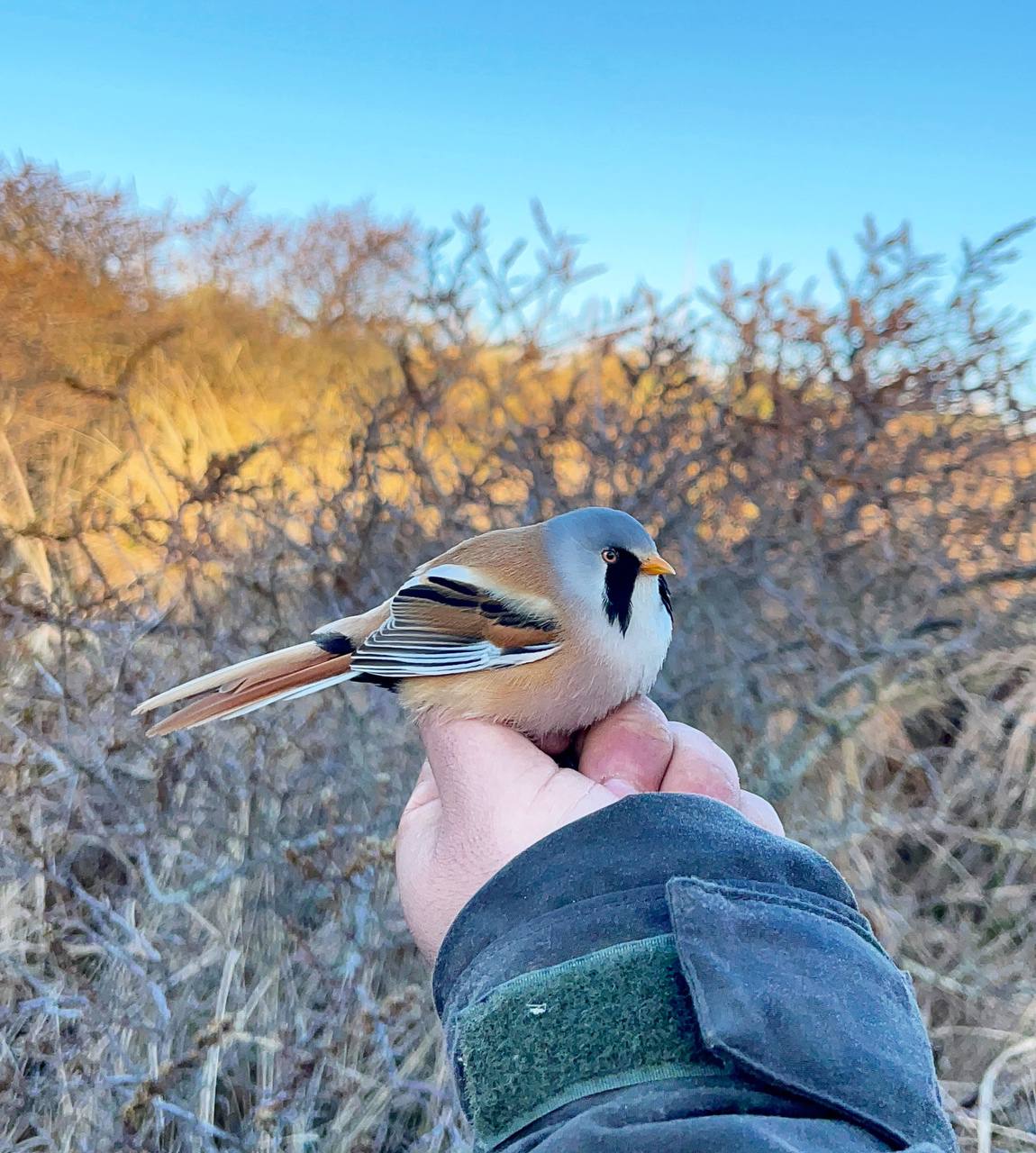
The birds were fascinating to observe, and we also heard 2 Grasshopper Warblers (Locustella naevia), Reed Warblers (Acrocephalus scirpaceus), Sand martins (Riparia riparia), Sedge Warblers (Acrocephalus schoenobaenus), Bitterns, Water rails (Rallus aquaticus), Cranes, and many more in the beautiful reed landscapes.
Towards the end of our rounds, we did a cormorant count in Cormorant Lake and found several active nesting sites, with a lone, Red-Necked Grebe (Podiceps grisegena) amongst the water dance of Grebes, with both species plunging into the lake to feed.
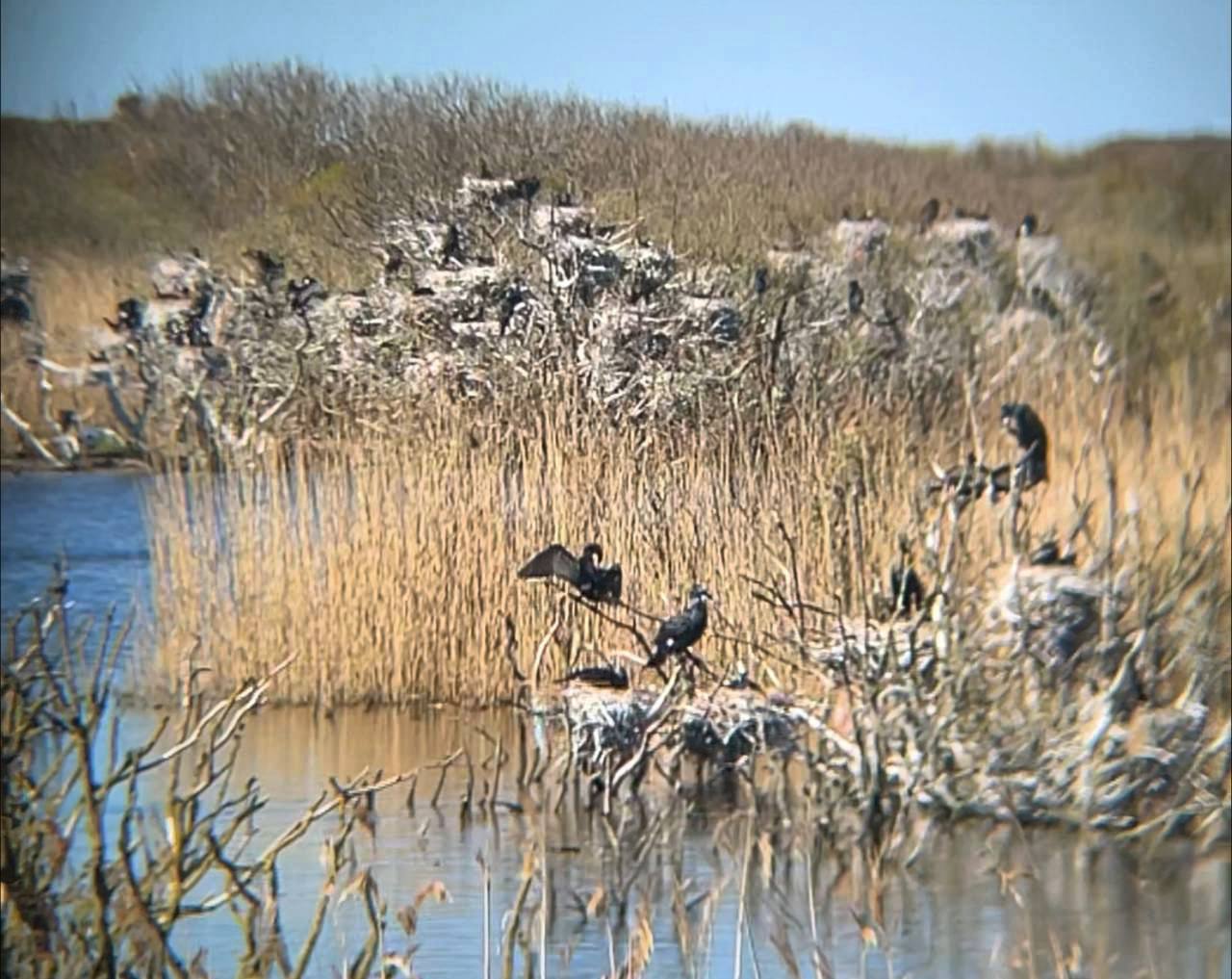
The day was full of learning opportunities. picking up many skills, from setting up the net to identifying species, differentiating their sex, holding, and releasing a bird. Everyone on site was kind and offered guidance to ensure we followed basic rules and protocols.
Meanwhile, Dante, Snäphor, and Martin, among other birders, observed a high sighting of a bird at 2600m altitude with laser binoculars.
After the ringing session, we went back to enter data from the morning's CES ringing session. We spotted an European Adder snake on our way out, which is the only venomous snake here in Denmark. So please stay on designated trails to stay safe while you're out!
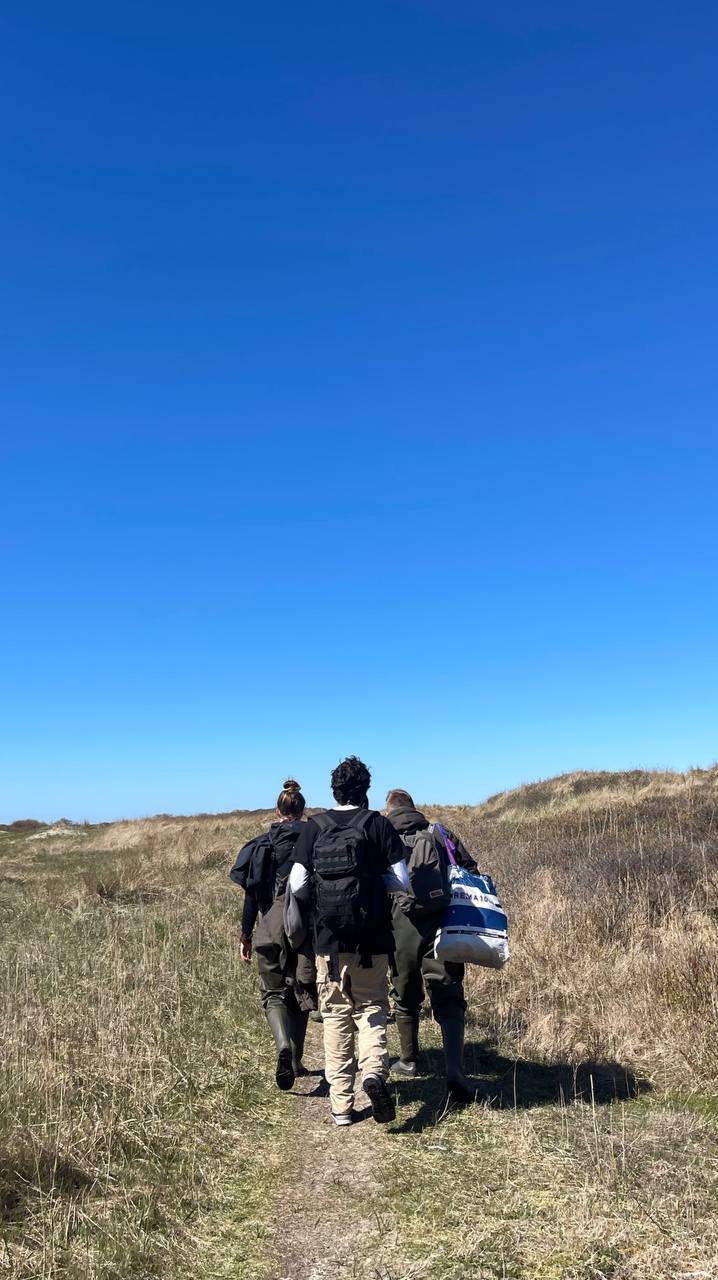
We concluded the day with a sharing session, setting up expectations and plans for tomorrow. I left the day feeling amazed at the experience, feeling very positive and eager for what’s to come!
P.S. There is a bike missing from our station, do let us know if you know where it is at :-) Thank you!
People: Yehonatan Ben Aroia, Michael Colley, Dante Shepherd, Lauren Evans, Simon S. Christiansen, Snäphor, Toh Ying Ying, Martin & Kristine.
Today’s observations in Dofbasen from observers in the area
Ringing (Skarvsøen CES):
Wren (Gærdesmutte): 3
Robin (Rødhals): 2
Sedge Warbler (Sivsanger): 1
Lesser Whitethroat (Gærdesanger): 1
Blackcap (Munk): 7
Chiffchaff (Gransanger): 13
Willow Warbler (Løvsanger): 15
Bearded Reedling (Skægmejse): 1
Reed Bunting (Rørspurv): 1
Total: 43
Fieldfares, Ring Ouzels and a Magpie
We all had high hopes that the switch to strong southerly winds and rain overnight would bring a few more birds to Skagen, and we were not disappointed. As soon as the rain stopped just after sunrise, Yehonatan and I sped over to Kabeltromlen to open the nets whilst Dante and Michael headed up to World’s End. Both the ringing and observing team had an excellent morning. Joined by our guests Martin and Kristine, Yehonatan, Simon, and I caught 32 birds including 2 Gærdesanger (Lesser Whitethroat) which have returned to Kabeltromlen this year after migrating south for the winter. The highlight of the morning was undoubtedly an adult, male Ringdrossel (Ring Ouzel), the first to be caught at the site this year and a new species in the hand for Yehonatan.
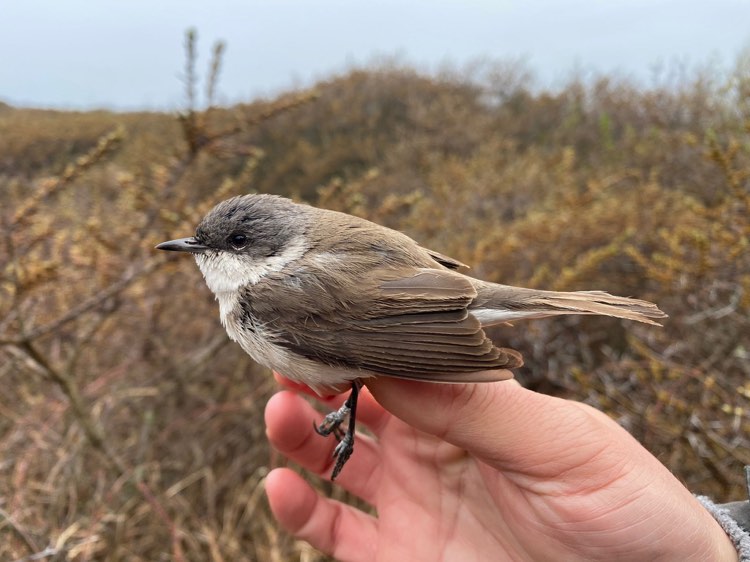
Gærdesanger (Lesser Whitethroat).
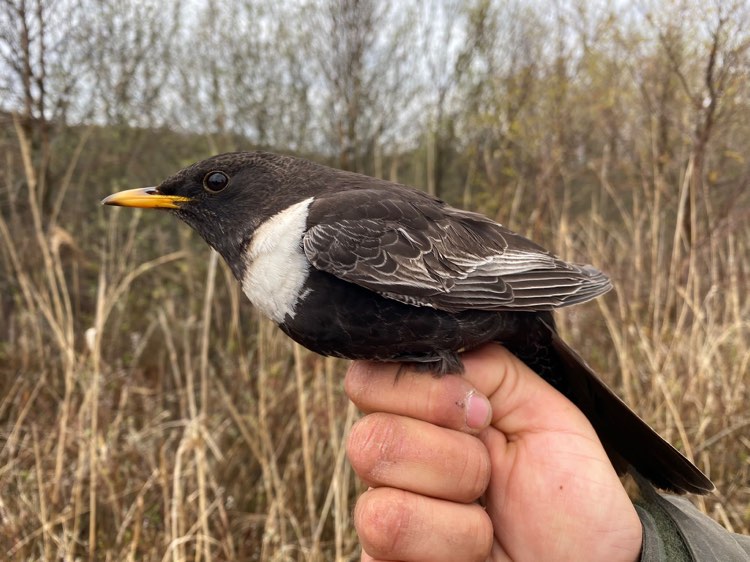
Ringdrossel (Ring Ouzel).
Meanwhile, up at World’s End, Dante, Michael and the other birders, had a brilliant morning with 2000+ Sjagger (Fieldfare), 77 Ringdrossel (Ring Ouzel), 64 Tinksmed (Wood Sandpiper), 3 Sortklire (Spotted Redshank), 5 Islom (Great Northern Diver) and Hvidnæbbet Lom (White-billed Diver).
The afternoon was spent entering data, upgrading ringing licences and making the final preparations for our first CES session of the year tomorrow until we heard that Lisa and Simon had caught a Husskade (Magpie) in their garden! They kindly bought it down to the observatory for us to ring and learn to age as this was a new species in the hand for all 4 of us volunteers.
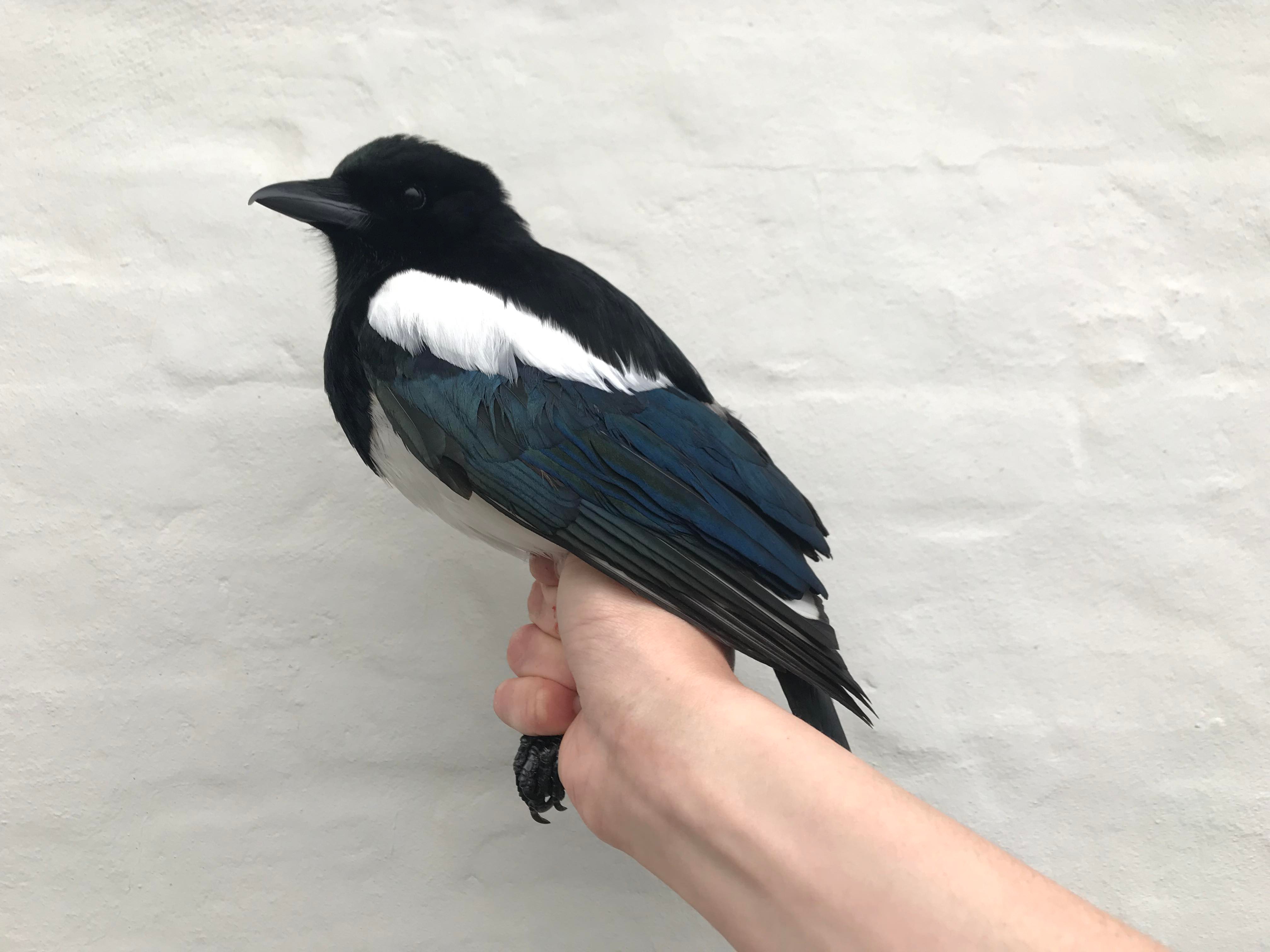
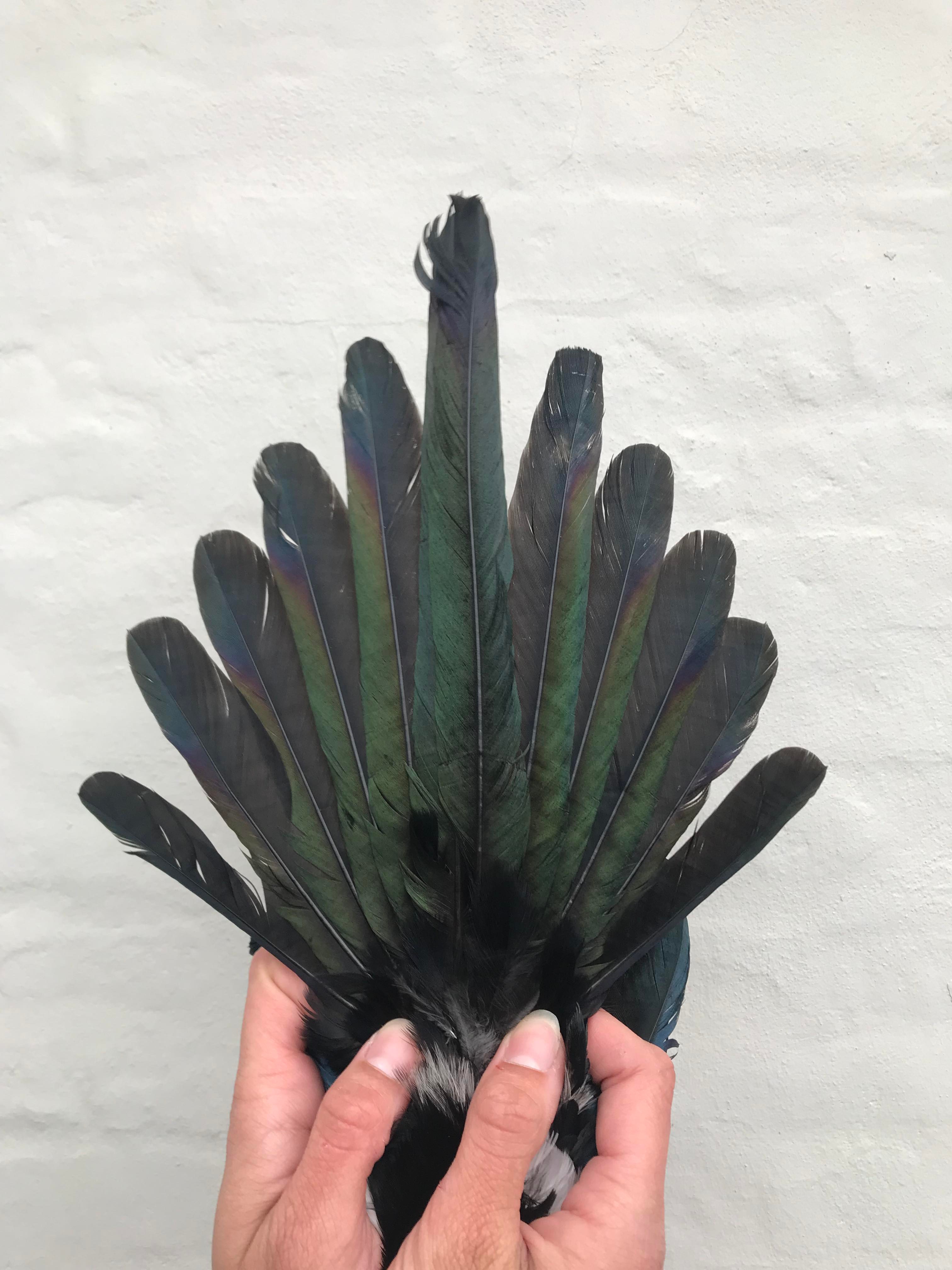
Husskade (Magpie) from Lisa and Simon's garden!
In other news, this evening we welcomed our newest volunteer, Ying, who will be with us for the week and is visiting from Aarhus University.
A full list of today's observations can be found here.
Skagen Fuglestation: Yehonatan Ben Aroia, Michael Colley, Dante Shepherd, Lauren Evans, Simon S. Christiansen, Lisa Vergin, Martin & Kristine.
Ringing (Kabeltromlen):
Gærdesanger (Lesser Whitethroat)- 2
Gransanger (Chiffchaff)- 12
Rødhals (Robin)- 5
Løvsanger (Willow Warbler)- 5
Gærdesmutte (Wren)- 1
Jernspurv (Dunnock)- 1
Munk (Blackcap)- 5
Sangdrossel (Song Thrush)- 3
Ringdrossel (Ring Ouzel)- 1
Ringing (Minervavej):
Husskade (Magpie): 1
Total: 35
